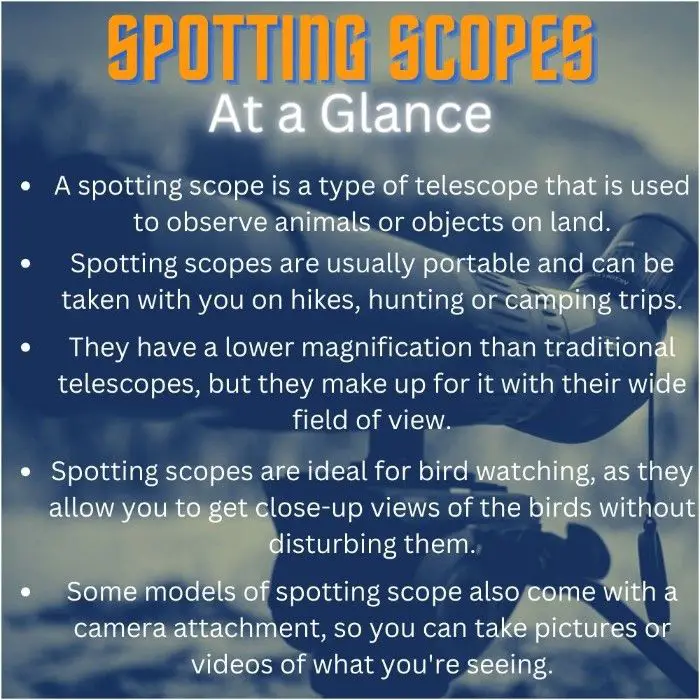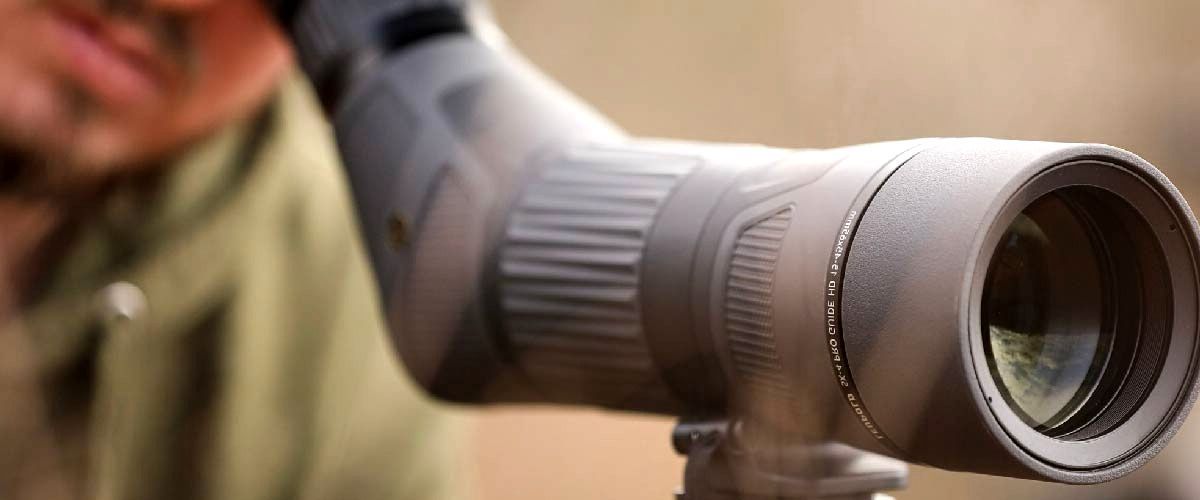A Quick Read on What is a Spotting Scope
Spotting scopes are optical devices used by birders and hunters to get a closer look at their target. These specialized devices are helpful to get a better view of objects that are far away. In this article, we'll take a closer look at spotting scopes and how they work.
Interested in getting a closer look at animals or birds or any activity that involves shooting?
A spotting scope can be a great investment for anyone who wants to get a better view of their target. They are handheld telescopes that provide a closer look than what you can see with the naked eye.
Spotting scopes come in different sizes and styles, so it's important to choose one that fits your needs. Some of the features to look for include magnification, lens size, and waterproofing.
Check out our article to learn more about spotting scopes and find the perfect one for you!

What is a Spotting Scope
A spotting scope is an advanced optical instrument used by outdoors enthusiasts and hunters to identify objects that are far away. Unlike most binoculars, a spotting scope has a long, adjustable barrel with intricate lenses that offer powerful magnification with clarity and precision.
It captures more light than the average pair of binoculars and produces sharp images—even from far away. With the right spotting scope by your side, you can easily spot wildlife or any other object in its natural environment while staying safely tucked away.
What is a Spotting Scope Used For
A spotting scope is an essential tool for a variety of outdoor activities, such as hunting, ornithology and bird watching, and target shooting, and if equipped with a high-quality roof prism, they even help in astronomical viewing. This telescope-style device features small diameter lenses that can magnify objects up to 60 times life size.
A spotting scope comes with an adjustable eyepiece and tripod mount, allowing for easy capture and accurate viewing. Spotting scopes are also engineered with fully multi-coated lenses which help reduce glare and provide superior color contrast.
Furthermore, many models include the option to adjust focus from one location or multiple distant locations at once through the use of a zoom wheel control.
With its range of uses and cutting-edge lens technology, the modern-day spotting scope is invaluable for any keen outdoorsman.
Check out this detailed video on spotting scopes:
How to Use a Spotting Scope
Using a spotting scope is easy, but it takes practice to get the most out of your investment. Here are some simple steps you should take when learning how to use a spotting scope:
1. Start by understanding how the different magnification settings work. Most spotting scopes will allow you to adjust the level of magnification, thanks to their zoom eyepiece so you can zoom in and out on your subject.
2. Mount your spotting scope securely on a tripod or other stand that can hold it steady while you observe. Make sure you have a good angle to observe your subject and that there are no obstructions in the way.
3. Use the appropriate eye relief for viewing through the spotting scope. Most scopes come with adjustable eyepieces, so you can adjust the distance your eye needs to be from the scope for comfortable viewing.
4. When you’re ready to observe, focus the eyepiece on your subject. This can take some time as there is often a lot of detail that needs to be finely adjusted in order to see objects clearly. Start by making small adjustments and then continue refining them until you get the best possible image.
5. When you’re done observing, make sure to securely place it inside a soft carrying case and store it away in a safe and dry place. The last thing you want is for your expensive device to be damaged by exposure to moisture or dirt. Clean it regularly with an appropriate lens cleaning cloth and keep any debris off the lenses.
It’s important to get familiar with the different settings so you can quickly adjust the scope when needed. Keep practicing and you’ll soon become an expert in using a spotting scope and be able to observe distant objects with ease. Enjoy!
How to Choose a Spotting Scope
Determining the right scope for your needs can seem like a daunting task, but it doesn't have to be. When choosing a spotting scope, the most important factor is the clarity of the image you get at different magnifications with its objective lens.
Other factors include portability, weight, and accessories available. If you intend to do long-distance viewing or digiscoping, higher magnification and large objectives are essential; however, they are also more difficult to manage in the field.
Smaller scopes with lesser magnification may be easier to use, but they might not give you the same clarity or resolution on distant subjects as much as a larger model.
Consider your priorities when selecting your scope–for example, portability vs maximum resolution–to ensure you have sufficient power for your intended use.
Lastly, chose whether you need an angled scope or a straight scope, where the scope body and the eyepiece are on the same axis.
How a Spotting Scope Compares With a Telescope, Monocular, and Binocular
Spotting scopes are highly specialized pieces of equipment that are used primarily for observing targets from very long distances. Generally speaking, a quality scope offers more range and power than either a monocular, or binocular. But they are less powerful than a telescope which is specially designed for astronomical viewing.
Spotting scopes typically have a large objective lens and more powerful magnifying lenses than any of the other monoculars and binoculars. They provide better light transmission over much longer distances, producing crisp images.
Additionally, spotting scopes feature greater stability due to their tripod systems meaning less overall shake when viewing faint objects.
Some even come with a car window mount. Like telescopes, some scopes have interchangeable eyepieces, which you can change depending on the astronomical, tactical, or hunting setting. Binoculars and monoculars lack this feature.
While all four options can offer unique benefits for traditional astronomy or other pursuits such as bird watching, the power, and range of a spotting scope make it the superior choice when attempting to observe distant objects clearly.
Final Words
Spotting scopes are great investments for anyone interested in bird watching or getting a closer look at nature or even hunting large game. Spotting scopes are usually less expensive than traditional telescopes, and some models even come with a camera attachment so you can take pictures or videos of what you're seeing.
And when you're interested in purchasing a spotting scope, just tap the button below to check out our top picks and get the one that fits your budget. We have done the hard work for you and whatever you choose, you won't be disappointed.
So get outside and start exploring the world around you with a new level of detail thanks to your trusty spotting scope.



